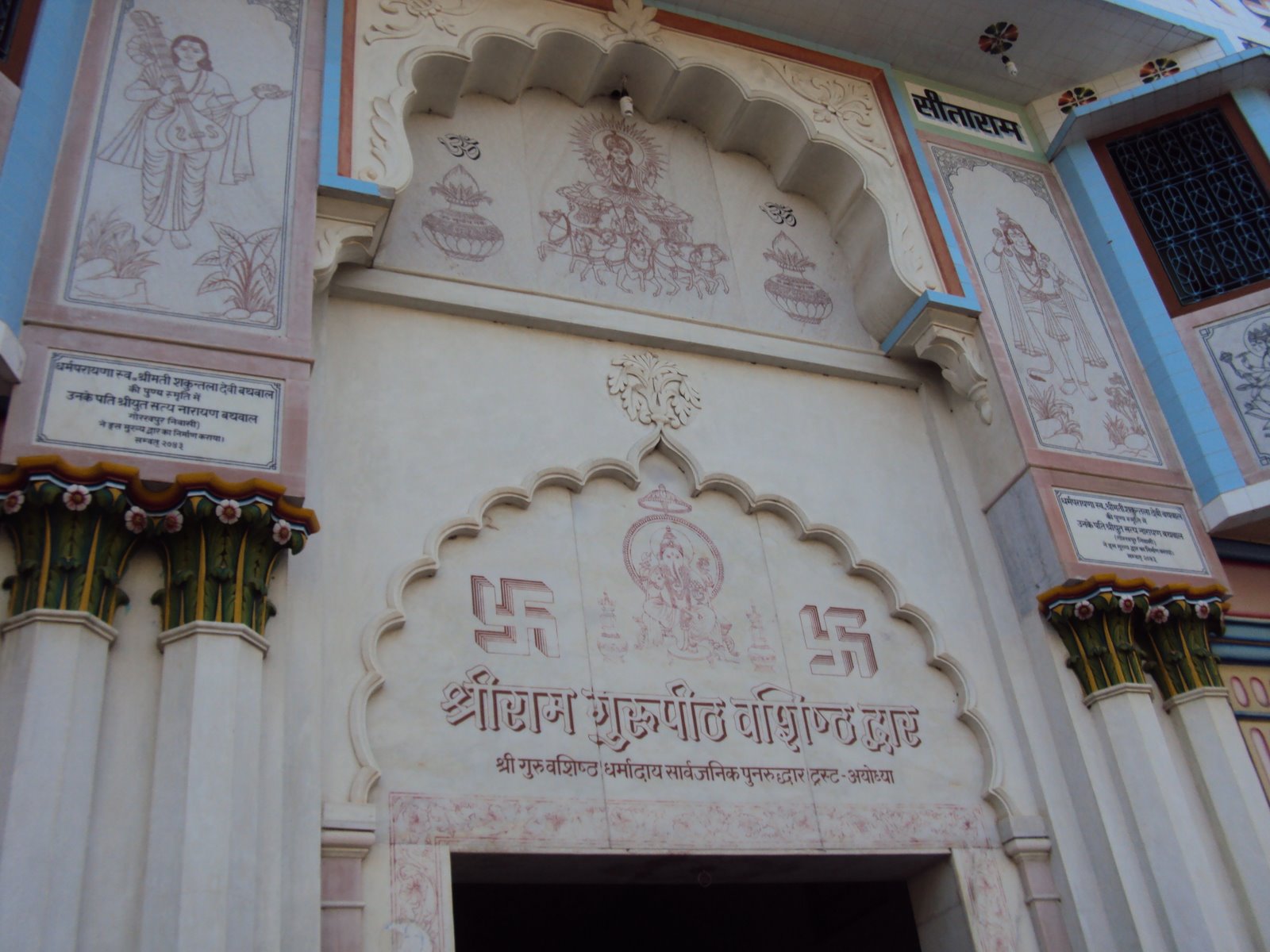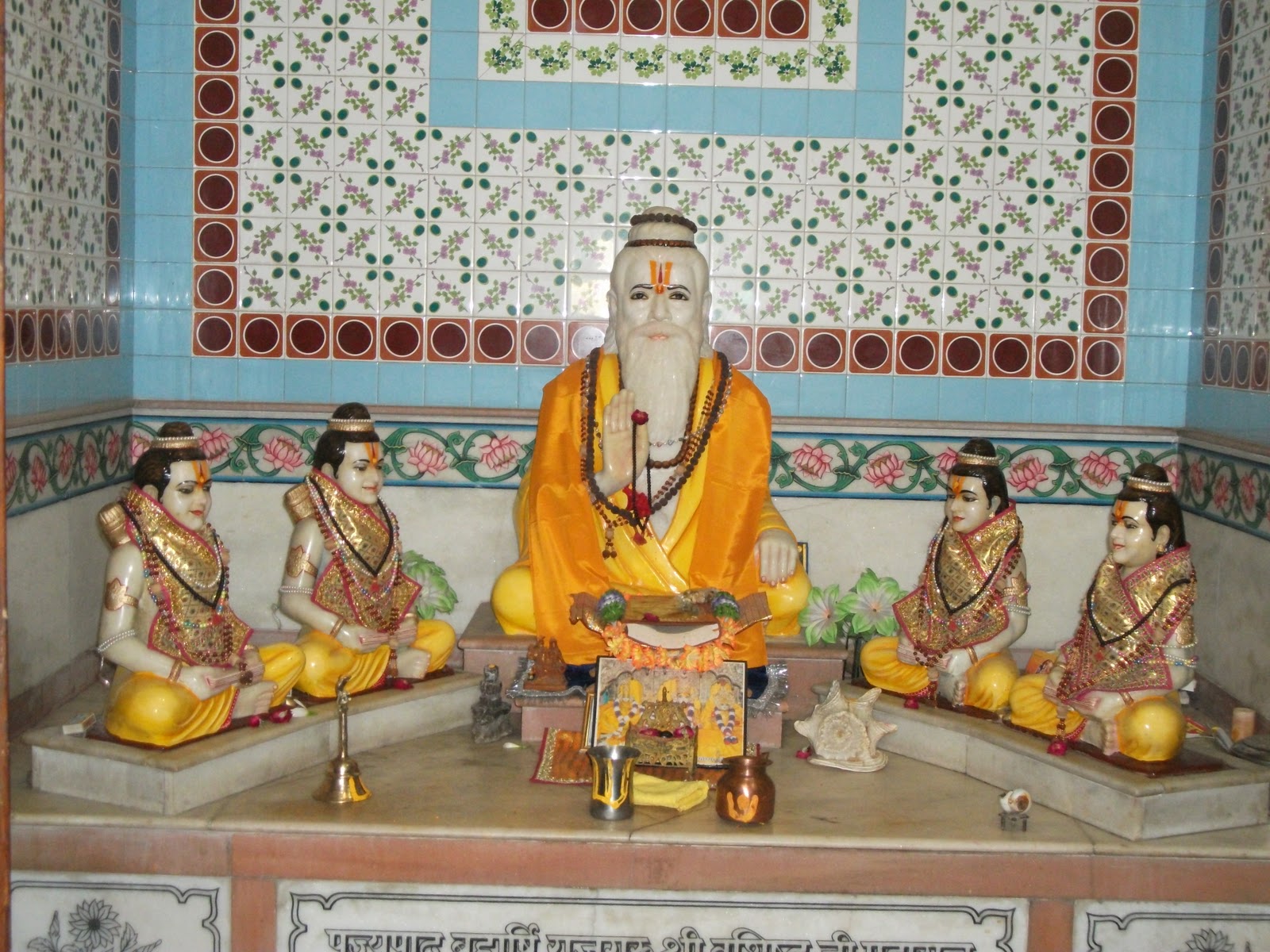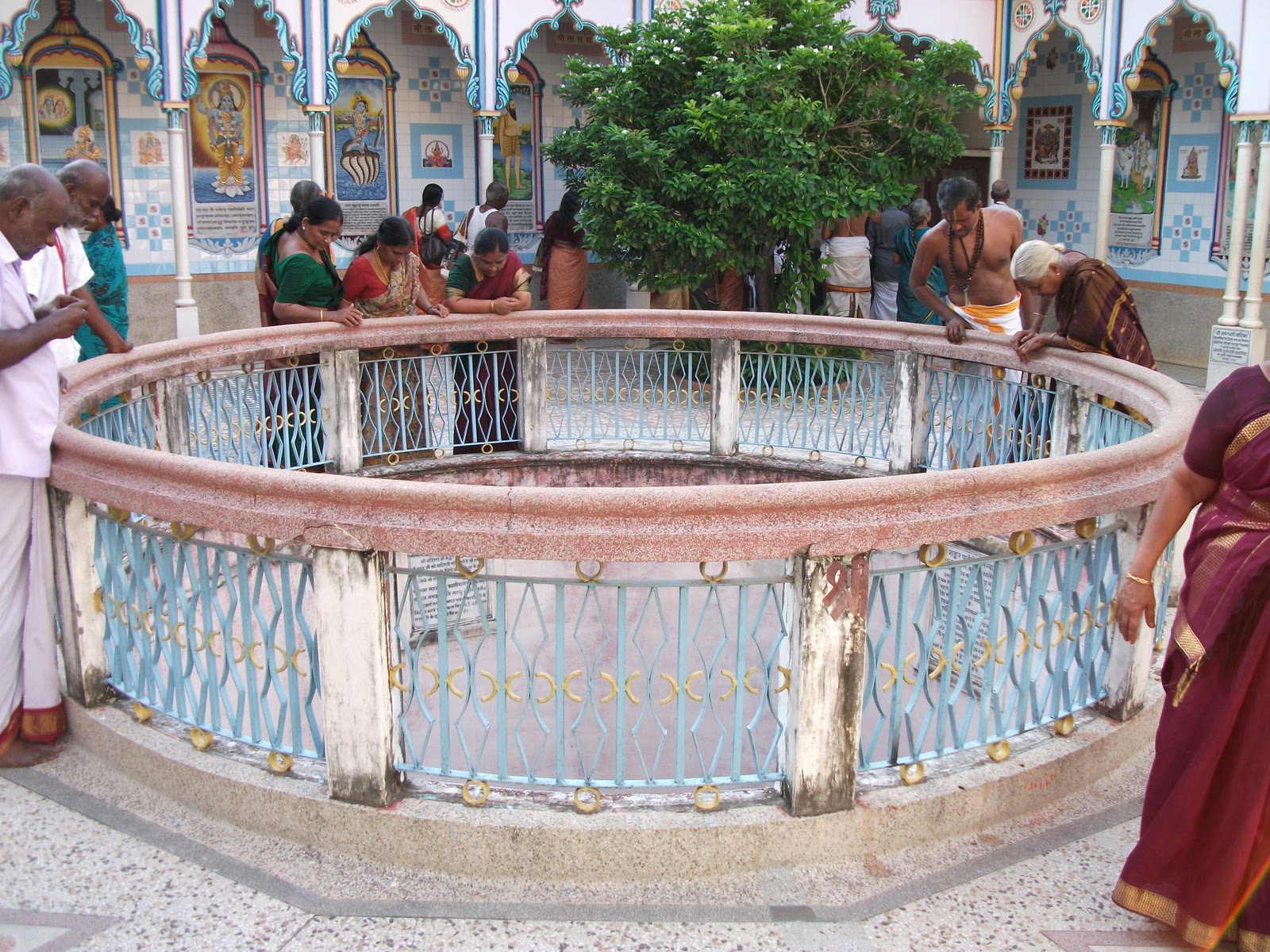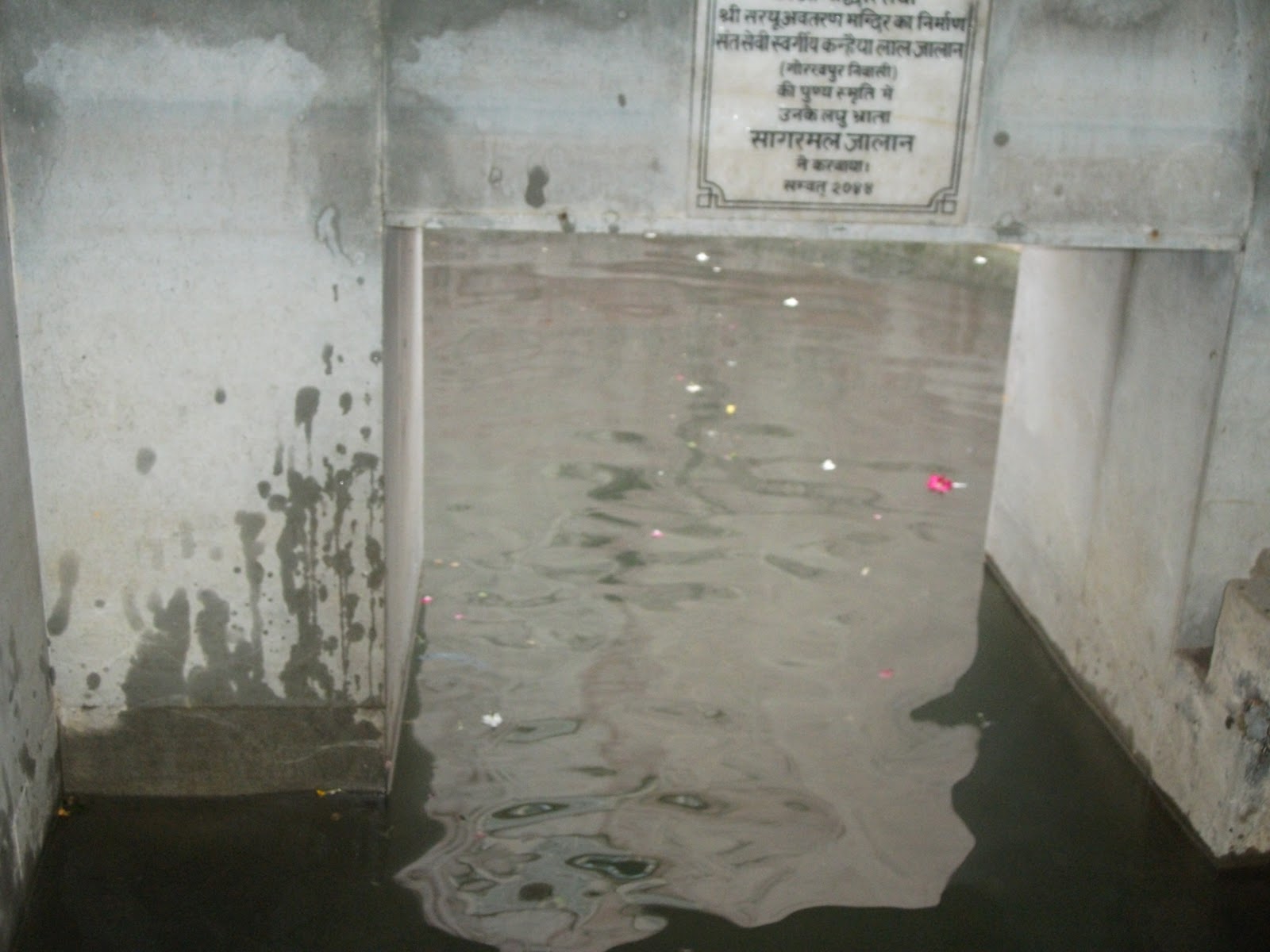
Jai Sita Ram...
Jai Hanuman...
In the footsteps of Lord Rama yatra, we are in Ayodhya. The accommodation to was arranged at Birla Dharmshala or Birla Mandir at Ayodhya. These type of Dharmshala's are built by wealthy people with spiritual view for the benefit of pilgrims which are available at affordable price, with common pond, well, park, common place to reside, Anna Dhana Koodam (dining hall), community hall etc. These kind of place, helps us to stay together. All the devotees participated in Sri Ramanin Padhaiyil were together at all the time.
We reached Vashishta Kund first from Birla Dharmshala by means of Autos and Rikshaws.

According to the famous Hindu epic "Ramayana", Brahmrishi Vasishtha had an Ashram in Ayodhya that was spread over 40 acres of land, where he lived with his wife "Arundhati". Today all that remains of it is a small ashram in about one fourth of an acre of land. The ashram has within it a well that is believed to be the source of the river Sarayu. This Vasishtha Kund is situated near Chakra Tirtha in the city of Ayodhya. Vasishtha Kund is a temple with a small round kund (pond) like a well. Now this Maharishi Vasishta Ashram is known as the Vasishta Kund. This is a beautiful temple which signifies the place where the 4 princes came to do gurukula vasa. That is, the 4 princes stayed here, at the Vasishta hermitage, to study. In fact so did all the kings before Lord Rama. The temple has lovely images of Vasishta and young Rama and his brothers which are almost life like.


At the age of 12, Lord Rama completed his studies. Looking at them one can actually imagine the 4 princes sitting around their Guru and learning. They look so eager to get on with their learning. At the basement of the main idol are multiple other idols of Saptarishi, Vasishta with his wife Arundhati, Kamadhenu cow, Hanuman, etc.
Meaning of Vasishta: Vash means to establish, to make to sit. And Ishta means the desired attributes, the desired qualities. Vashishta who has established the desired qualities within his own self.
Meaning of Arundhati: The root of the name is the Sanskrit word rudh, meaning "to restrain," and the prefix a, which means "not." (One who does not stop any kind of Dharma activities)



When you come out of this underground temple are into an open courtyard, there are steps that go further down to a water tank. The miracle is that the water level in this tank changes with the water inflow into the river Sarayu. There is no direct visible connection to the river yet the tank is influenced by how much water the Sarayu carries. This small tank which can be seen from the top. It is a very serene and calm place. The fruit of bathing in the kund is the attainment of knowledge like Vasishta Maharishi according to the prevalent belief of the seers.

One can find the fire altar (homa/havan or yagna kundam) here, where Putra Kameshti Yagna was performed by King Dasharatha under the supervision of Rishi Shringa Muni, upon the recommendation of Sage Vashishta.


We can find one more Yagna shala (place for sacrificial fire ceremonies) 20 Kms from Ayodhya known as Makauda Ghat. Located on the banks of river Sarayu. Sage Rishi Sringar, illustrious son of Sage Vipandaka was the priest presiding over the Putrakameshti Yajna performed by Emperor Dasaratha seeking child boon. This yagna was performed here, at the close of the yagna. There emerged a greatly vigorous and energetic Divine Being with an unparalleled resplendence, called Yagna Purusa in the homa/yagna with a golden pot/bowl consisting of payasam or kheer (divine pudding).

We all performed parayanam (recitation) of Valmiki Ramayana - Bala Kanda's 16th Sargam (Chapter - The success of Putrakamesti) in Sage Vasishtha Kund.
Hearing the plea of King Dasaratha, a divine being, purusha, emerges from the holy sacrificial fire, bearing a bowl of payasam, a milk sweet, and asks Dasaratha to feed the sweet to his wife; she would then have a son. The king then gave half of the payasam to queen Kausalya, and he gave half of the half, i.e., one fourth to queen Sumitra. And to Kaikeyi he gave half of the remaining half, i.e., one eight of the payasam, with a desire to beget sons. Then thinking for a while gave the remaining, i.e., one-eighth portion again to queen Sumitra. Thus, the king distributed the payasam to his wives differently.
Payasam was distributed in the order of Kausalya, Sumitra and Kaikeyi. But it was not consumed in the same order, let see how it was consumed. The Deva gave the vessel to King Dasaratha and asked him to distribute the payasam to his wives, so that after drinking they would concieve children. First, Dasaratha made the payasam into Two halves and gave one half to Kausalya. She drank that and later Sri Rama was born to her. Then, Dasaratha, halved the remaining half and gave that quarter portion to Sumitra. She did not drink immediately, but was waiting. Then, Dasaratha, halved the remaining quarter portion of the payasam and gave that one-eighth quantity to Kaikeyi. Keikeyi thought that since Kausalya had drunk the portion given to her and Sumitra was yet to drink and so if she drank her portion immediately, her son could be Prince!. Dasaratha was wondering to whom he could give the last remaining one-eighth portion. After a long thinking, he gave the balance also to Sumitra. With Two portions of the payasam in her hands, Sumitra prayed that she should give birth to two children, one to serve Son of Kausalya, her senior and one to serve son of Kaikeyi, her junior. Then she drank both together and later gave birth to Lakshmana and Shatrugna. Lakshmana was Sri Rama's devotee and Shatrugna was Bharata's devotee. One was serving the Lord and the other was serving the Devotee of the Lord. All of them conceived and after 12 months gave birth to four princes.
Jai Hanuman...
In the footsteps of Lord Rama yatra, we are in Ayodhya. The accommodation to was arranged at Birla Dharmshala or Birla Mandir at Ayodhya. These type of Dharmshala's are built by wealthy people with spiritual view for the benefit of pilgrims which are available at affordable price, with common pond, well, park, common place to reside, Anna Dhana Koodam (dining hall), community hall etc. These kind of place, helps us to stay together. All the devotees participated in Sri Ramanin Padhaiyil were together at all the time.
We reached Vashishta Kund first from Birla Dharmshala by means of Autos and Rikshaws.
Vashishta Kund, Ayodhya:
According to the famous Hindu epic "Ramayana", Brahmrishi Vasishtha had an Ashram in Ayodhya that was spread over 40 acres of land, where he lived with his wife "Arundhati". Today all that remains of it is a small ashram in about one fourth of an acre of land. The ashram has within it a well that is believed to be the source of the river Sarayu. This Vasishtha Kund is situated near Chakra Tirtha in the city of Ayodhya. Vasishtha Kund is a temple with a small round kund (pond) like a well. Now this Maharishi Vasishta Ashram is known as the Vasishta Kund. This is a beautiful temple which signifies the place where the 4 princes came to do gurukula vasa. That is, the 4 princes stayed here, at the Vasishta hermitage, to study. In fact so did all the kings before Lord Rama. The temple has lovely images of Vasishta and young Rama and his brothers which are almost life like.
At the age of 12, Lord Rama completed his studies. Looking at them one can actually imagine the 4 princes sitting around their Guru and learning. They look so eager to get on with their learning. At the basement of the main idol are multiple other idols of Saptarishi, Vasishta with his wife Arundhati, Kamadhenu cow, Hanuman, etc.
Meaning of Vasishta: Vash means to establish, to make to sit. And Ishta means the desired attributes, the desired qualities. Vashishta who has established the desired qualities within his own self.
Meaning of Arundhati: The root of the name is the Sanskrit word rudh, meaning "to restrain," and the prefix a, which means "not." (One who does not stop any kind of Dharma activities)
When you come out of this underground temple are into an open courtyard, there are steps that go further down to a water tank. The miracle is that the water level in this tank changes with the water inflow into the river Sarayu. There is no direct visible connection to the river yet the tank is influenced by how much water the Sarayu carries. This small tank which can be seen from the top. It is a very serene and calm place. The fruit of bathing in the kund is the attainment of knowledge like Vasishta Maharishi according to the prevalent belief of the seers.

One can find the fire altar (homa/havan or yagna kundam) here, where Putra Kameshti Yagna was performed by King Dasharatha under the supervision of Rishi Shringa Muni, upon the recommendation of Sage Vashishta.
Makauda Ghat:


We can find one more Yagna shala (place for sacrificial fire ceremonies) 20 Kms from Ayodhya known as Makauda Ghat. Located on the banks of river Sarayu. Sage Rishi Sringar, illustrious son of Sage Vipandaka was the priest presiding over the Putrakameshti Yajna performed by Emperor Dasaratha seeking child boon. This yagna was performed here, at the close of the yagna. There emerged a greatly vigorous and energetic Divine Being with an unparalleled resplendence, called Yagna Purusa in the homa/yagna with a golden pot/bowl consisting of payasam or kheer (divine pudding).

We all performed parayanam (recitation) of Valmiki Ramayana - Bala Kanda's 16th Sargam (Chapter - The success of Putrakamesti) in Sage Vasishtha Kund.
Hearing the plea of King Dasaratha, a divine being, purusha, emerges from the holy sacrificial fire, bearing a bowl of payasam, a milk sweet, and asks Dasaratha to feed the sweet to his wife; she would then have a son. The king then gave half of the payasam to queen Kausalya, and he gave half of the half, i.e., one fourth to queen Sumitra. And to Kaikeyi he gave half of the remaining half, i.e., one eight of the payasam, with a desire to beget sons. Then thinking for a while gave the remaining, i.e., one-eighth portion again to queen Sumitra. Thus, the king distributed the payasam to his wives differently.
Payasam was distributed in the order of Kausalya, Sumitra and Kaikeyi. But it was not consumed in the same order, let see how it was consumed. The Deva gave the vessel to King Dasaratha and asked him to distribute the payasam to his wives, so that after drinking they would concieve children. First, Dasaratha made the payasam into Two halves and gave one half to Kausalya. She drank that and later Sri Rama was born to her. Then, Dasaratha, halved the remaining half and gave that quarter portion to Sumitra. She did not drink immediately, but was waiting. Then, Dasaratha, halved the remaining quarter portion of the payasam and gave that one-eighth quantity to Kaikeyi. Keikeyi thought that since Kausalya had drunk the portion given to her and Sumitra was yet to drink and so if she drank her portion immediately, her son could be Prince!. Dasaratha was wondering to whom he could give the last remaining one-eighth portion. After a long thinking, he gave the balance also to Sumitra. With Two portions of the payasam in her hands, Sumitra prayed that she should give birth to two children, one to serve Son of Kausalya, her senior and one to serve son of Kaikeyi, her junior. Then she drank both together and later gave birth to Lakshmana and Shatrugna. Lakshmana was Sri Rama's devotee and Shatrugna was Bharata's devotee. One was serving the Lord and the other was serving the Devotee of the Lord. All of them conceived and after 12 months gave birth to four princes.


0 comments:
Post a Comment